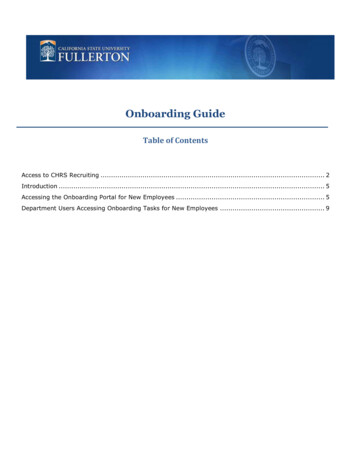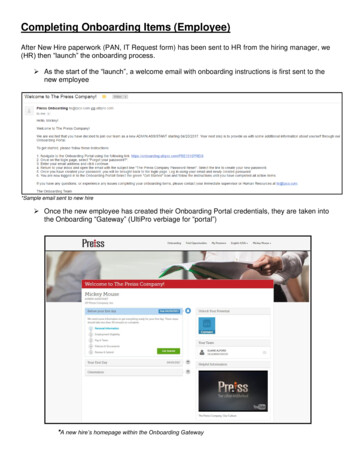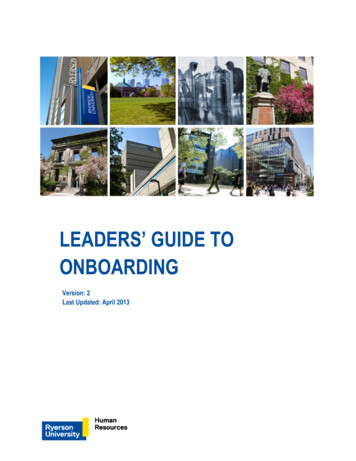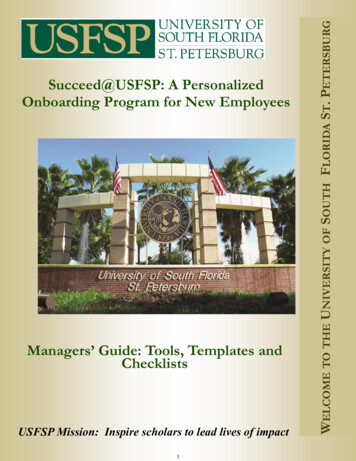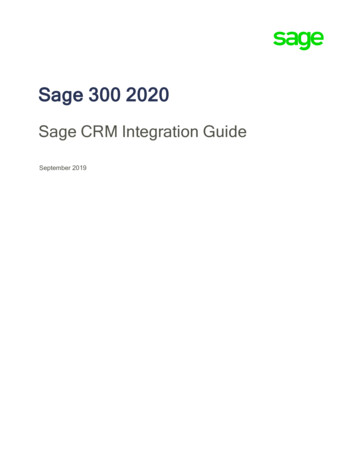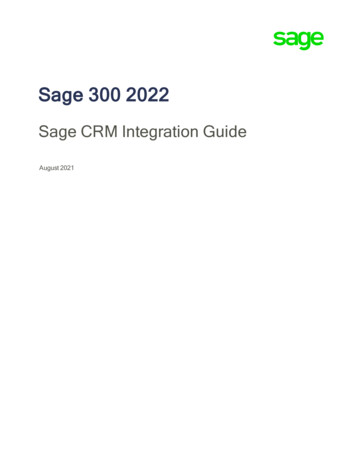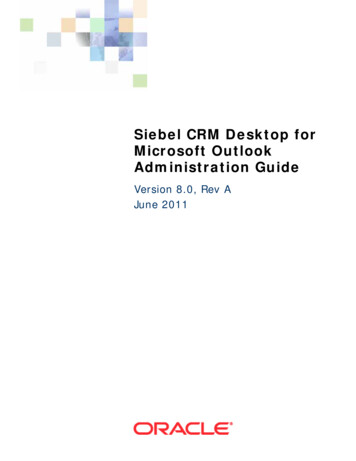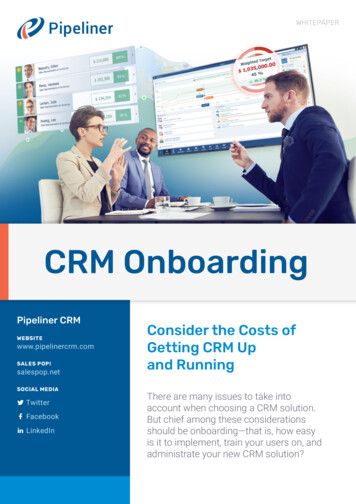
Transcription
WHITEPAPERCRM OnboardingPipeliner CRMWEBSITEwww.pipelinercrm.comSALES POP!salespop.netSOCIAL MEDIA Twitter Facebook LinkedInConsider the Costs ofGetting CRM Upand RunningThere are many issues to take intoaccount when choosing a CRM solution.But chief among these considerationsshould be onboarding—that is, how easyis it to implement, train your users on, andadministrate your new CRM solution?
WHITEPAPERThere are several reasons to payattention to onboarding:利利The longer it takes to integrate and bring the system online,the longer will it will take before your CRM solution beginsshowing a return on investment.利利The same is true for the length of time it takes to train your users.This is especially significant if a CRM application is complex andhas a long training runway. The most important CRM users areyour sales reps. How long can your company afford sales repdowntime while they’re training on CRM, even part time? Anotherfactor is that salespeople are slowed down in sales velocity asthey’re having to train, while they’re forced to work back and forthbetween existing solutions and the new CRM solution.利利Administration can reap serious cost when it comes toimplementing a new CRM solution. With traditional CRMapplications, there is training needed for CRM administrators.Then once the solution is up and running, it can take one andsometimes more full-time administrators for CRM.This White Paper addresses the various factors of CRM onboardingin detail—and illustrates with real-world numbers how Pipeliner CRMaddresses these issues for a fraction of the cost of its competitors.We have also added in data from our Customer Satisfaction Survey toassist you in further deciphering the differences between Pipeliner andthe competition.1. Administrative OnboardingWhen an organization decides on a CRM solution, the task of integratingit into the company falls upon IT staff or system administrators. Theymust port data in, integrate CRM with existing applications, test it ina live scenario, make CRM live, and get users trained on it.The length of time it takes for onboarding, and the investment ofresources in terms of personnel, should be a crucial factor in decidingon a CRM solution. While user training is an overall part of onboarding,for the purposes of this section let us set that aside (we’ll be examiningit separately) and simply examine it from an administrator’s role.Complexity as a GuideThe complexity of the system is an important clue to the speed andexpense of onboarding.You can discover its complexity by reading about the system onthe web, or better yet by obtaining a demo and trying it out. The numberof parameters that need to be set, the functionality that needs to betailored to your needs, the number of user roles that need to be definedand set, the difficulty of integrating the CRM system with your existing2
WHITEPAPERapplications, the ease with which data can be ported, and other factorscan all be indications of a system’s relative complexity.1. How complicated was it to getPipeliner CRM up and running atyour company?9%Very Easy68%Easy, but withminor Developers contend that complexity should not be an issue when itcomes to fully supporting your company’s customer relationships. Thisargument, however, holds less water as time goes by. Companies don’thave time to wade through tomes of documentation—or worse, throughhours, days or weeks of administrator training—just to onboard theirCRM application.Some Hard FiguresHow long does it take to onboard the most common CRMsolutions versus Pipeliner CRM?We took a look at the onboarding claims of our most frequentcompetitors, and this is what we found:30 days. — Salesforce.com“A matter of days or weeks.” — Oracle CRM“Can take weeks or months.” — Sugar CRM2. Once you decided to go withPipeliner CRM – How long was thePipeliner CRM onboarding process atyour company?14%Less than 1 day41%1 to 5 days14%6 to 10 days31%More than10 days0%25%50%75%“In a very simple installation, about 4 weeks.” — MS Dynamics CRM“A matter of weeks.” — SAP CRMNote that these are claims made by the companies themselves, and dueto the complexity of these applications it’s quite likely the statementsare optimistic.We know how long it generally takes a new client to onboard PipelinerCRM. But we went one step further and actually asked our customersseveral multiple-choice questions about the speed and ease ofonboarding Pipeliner CRM, so you wouldn’t have to take our word for it.When asked how complicated it was to get Pipeliner CRM up andrunning at their companies, 77% of Pipeliner customers surveyed foundPipeliner “Very easy” or “Easy, but with a few minor issues”.— survey question #1100%3. How was the implementationInstead of our competitors’ stated weeks or months toget CRM up and running, 41% of Pipeliner CRM customersreported that it took “1 to 5 days”. 14% said it took “Lessthan 1 day”, while another 14% stated that it took “6 to 10days”. — survey question #245%Very EasyIn our Customer Satisfaction Survey, we asked how easythe implementation and rollout for Pipeliner had been. The vastmajority—86%—answered “Easy” or “Very Easy”.— survey question #341%Easy8%Difficult6%Very Difficultand roll-out of Pipeliner CRM in yourorganization?0%25%50%75%An important aspect of getting a new CRM up and running isdata migration. 64% of respondents in our Customer Satisfaction Surveystated that data migration into Pipeliner was “Easy” or “Very Easy.”— survey question #4100%3
WHITEPAPERTo assist onboarding, Pipeliner provides an in-depth help function withinthe product as well as assistive materials on our website.4. How easy was it to migrate data71% of those surveyed said that they found most of the help theyneeded in the product help or on the website, with only a few otherissues needing more inquiry. Another 24% reported that they foundeverything they needed within those resources. — survey question #521%Very Easy43%EasyNew customers onboarding a new CRM system may require support,so we asked about the quality of Pipeliner support in our CustomerSatisfaction Survey. 86% of respondents replied that support was“Good” to “Excellent.” — survey question #618%Difficult18%We haven’tmigrated any datainto Pipeliner CRM?0%25%50%75%100%5. How helpful were the PipelinerCRM product and web site?24%Very Helpful, I foundeverything I needed71%Helpful, I had a fewminor issues5%Difficult, it was hard to findwhat I needed0%Very Difficult, I didn’tfind what I needed0%25%50%75%PricingOf course pricing affects onboarding, and costs of ongoing use. You’lloften find that for the more complex products, the pricing modeltends to be complex as well. Below are listed pricing models for the 5competitors cited in this White Paper—and then Pipeliner’s.Salesforce.comPrices per user / month, billed annually.Salesforce Essentials: Out of the box CRM for up to 5 users: 25(no customization or extra features)Lightning Professional: Complete CRM for any size team: 75Lightning Enterprise: Deeply customizable CRM for business: 150Lightning Unlimited: Unlimited CRM power and support: 300Oracle CRMPrices per user / month, billed annually.Oracle CRM on Demand: Pricing begins at 75The single-tenant Standard version: 90 (whereby Oracle dictatesthe maintenance and upgrade schedule)100%6. How would you rate Pipeliner’scustomer support?The single-tenant Enterprise edition: 125 (whereby the customerdictates the maintenance and upgrade schedule)Oracle customers may deploy Oracle CRM on Demand for 110Sugar CRM10%The product works so wellwe haven’t needed support47%Excellent39%Good4%Not Satisfactory0%25%50%75%100%Prices per user / month, billed annually.Sugar Professional: 40Sugar Enterprise: 65Sugar Ultimate: 150Microsoft Dynamics CRMPrices per user / month, billed annually.Dynamics 365 for Sales Professional: 65Dynamics 365 for Sales Enterprise: 95Microsoft Relationship Sales: 1304
WHITEPAPERSAP CRMPrices per user / month, billed annually.Costs for SAP CRM can be a bit misleading, because in addition tothe CRM cost the client must also pay for the SAP ERP platform, alongwith additional models needed for additional functionality. The three toptiers are:Enterprise SCM: 199Enterprise Standard: 149Team User CRM Sales: 89SAP also requires a minimum of 15 user subscriptions.Pipeliner CRMPrice per user / month, billed annually.Pipeliner offers 3 versions of its top-rated CRM, at 3 different pricepoints, to meet the needs of businesses of all sizes.Starter: Basic sales management, tracking and collaboration: 25.Business: Full CRM functionality, advanced reporting, customization andunique productivity features: 65.7. Did you find the PipelinerCRM pricing model simple andstraightforward?Enterprise: Full enterprise CRM functionality with advanced reporting,advanced customization, integrations and services: 85.86%Yes8%Somewhat6%No, differentthan others0%No, it’scomplicated0%25%50%75%100%8. With regards to Administrativetime for Pipeliner CRM, does yourcompany require:57%No administrator at all,users are admins43%Part-time CRM administrator,a few hours per week0%Full-time CRMadministrator0%More than 1 full-timeCRM administrator0%25%50%75%SEE WHAT YOU ARE PAYING FORSubsequent Administrative DemandsA certain amount of focused administrative time will be required to geta CRM system onboarded and into operation. The amount of time andeffort, as stated earlier, depends on the complexity of the system.But what about after the system is up and running?All of the competitors we mentioned usually require a minimum ofone to two full-time CRM administrators, depending on the size ofthe company. Especially when added to the cost of the CRM applicationitself, this is a substantial investment for a company. Additionally ourcompetitors can require days to weeks of training for administrators.According our survey of Pipeliner CRM customers, none require morethan a part-time administrator. And administrator training can be donein a matter of hours or, at most, a few days part-time.— survey question #8100%5
WHITEPAPER2. Training of UsersIn the scheme of onboarding a CRM solution, user training takesa considerable amount of attention and effort. This is no surprise, asthe majority of CRM ROI rests on how quickly users can be broughtup to speed, and how involved they will become in actually usingthe system.As with overall implementation, the length of time to train usersdepends to a large extent on the complexity of the system. Butcomplexity also has a profound effect on another aspect of usertraining, and beyond that the actual adoption of the CRM solution: theirwillingness to use it. In the past far too many companies have more orless ignored user adoption. IT executives chose the CRM application,company executives approved the purchase and gave the go ahead,and nobody ever looked back. The sales reps—not only a company’sfront line of business and revenue but the primary users of CRM—werenever consulted.Is it any wonder that most salespeople are bitter aboutCRM applications?The users’ willingness to use a system, which of course has a directimpact on training, hinges on yet another factor.Ease of UsePerhaps the most overused term in software marketing is “ease of use.”But this much-hyped buzzword does tell a very important tale, especiallyon the topic of CRM—so much so that you won’t find a CRM developeranywhere that doesn’t make this claim.But the fact is that traditional CRM solutions have been anything buteasy to use. They have been complex, difficult and time consumingto train on, and the target of endless complaints. In fact, if you wereto randomly poll salespeople on CRM, you would find the far majorityresponding negatively.The underlying reason for this animosity is that CRM applications havenot been designed to aid salespeople in their sales, but as reportingmechanisms so that sales reps can be managed.When a CRM solution is intuitively designed fromthe beginning with salespeople in mind, threethings happen:1. Training takes less time, because salespeople are actuallyenthusiastic about using the product.2. The ROI happens much more quickly because salespeopleare actually using it, and not the other solutions (their ownspreadsheets or notes) they might have had in place previously.3. Because the application is designed to facilitate a salesperson’sjob, it is factually intuitive and easy to use.6
WHITEPAPERTraining Time Comparisons9. How intuitive do you findPipeliner CRM to use compared withother systems?53%Very Intuitive37%SomewhatIntuitive10%The Same0%Not Very Intuitive0%25%50%75%100%CRM training for your sales reps andcompany personnel?33%Very effective57%Mostly effective,we had some questions5%Somewhat effective, a lotof follow-up questions5%Ineffective25%50%75%100%11. How long did it take for yourusers to become proficient usingPipeliner CRM?18%Less than a week39%2 weeks27%1 month16%2-3 months0%25%50%75%You can more or less gauge the user training runway yourself, though—just have a look at the complexity of the system, and the differentfunctions that each user must learn. A factor to consider is: Howintuitive is the application, and how well does it natively fit in withthe functions of a sales rep’s job? That will certainly be key to the speedof learning for a salesperson.In our Customer Satisfaction Survey, we asked how intuitive users foundPipeliner to be. 90% found Pipeliner to be “Intuitive” to “Very Intuitive.”— survey question #9Training Efficiency10. How effective was the Pipeliner0%Fortunately or unfortunately, no CRM developer, not even the leadingones, actually states how long user training will take. However usertraining would normally be included in the overall onboarding time, asquoted above.Another aspect of training to examine is the efficiency of the trainingoffered by the vendor. If you Google a particular CRM application alongwith keywords such as “user training” or “sales rep training” you willfind courses offered by that vendor and others, along with evaluationsof training. You may be in for some surprises. For example, one courseoffered by Salesforce.com is 42 hours long. Another company offersadvice on “overcoming endless Salesforce training” and yet another on“overcoming sales rep resistance” to learning and using the application.None of these would serve as rousing endorsements for thatparticular product.All of the others offer many courses of varying lengths—and the factthat these vendors have to offer courses at all is an indication thattraining users on them is a complicated affair.Because Pipeliner CRM was designed to be intuitive forusers, training is commonly done in as little as a fewhours to a few days. No formal training courses areoffered or required.How efficient is our user training? Turning back to our survey ofcustomers, 33% of our customer survey respondents stated that ourtraining was very effective and the company was able to get up andrunning with Pipeliner right away. Another 57% stated that they still hada very few questions after the training, but these got answered rightaway and they were off and running. — survey question #10In our Customer Satisfaction Survey, 58% of those surveyed stated thatit took 2 weeks or less to become proficient using Pipeliner. — surveyquestion #11100%7
WHITEPAPER3. Flexibility12. On average, how often do youchange your sales process stagesor the custom field templates withinPipeliner CRM?5%Often, morethan once a month38%Semi-regularly, atleast once per quater43%Seldom, maybe onceor twice per year14%Never0%25%50%75%100%13. When you do have to changeyour sales process or field templateswithin Pipeliner CRM, how easy is it?Another key factor in onboarding CRM is the customization ofthe application to a company’s sales process. In the last few yearsthe importance of a company’s sales process has taken a considerablespotlight. Companies with a tried-and-true sales process haveconsistently higher revenue and better sales velocity than those thateither don’t have a sales process or pay only passing attention to it.Forward-looking companies utilize a sales process that is dynamic—thatchanges to reflect variations in the market, economy, product or serviceimprovements and sales innovations. A company that casts their salesprocess in stone is ignoring the one constant of the universe: change.What happens when a sales process—or any of its steps—becomesoutmoded or improved? Suddenly sales reps are off of that salesprocess and onto one of their own making, each rep potentially actingon their own “sales process.”When this happens it also has a profound affect on sales management.When a sales process is established and agreed upon, and all repsare following it, management is simplified because the sales managerknows exactly in which direction salespeople are going with each oftheir opportunities. But when that sales process isn’t used, confusionand chaos result because the sales manager is trying to keep a handleon all in-progress opportunities.CRM and Sales Process71%Very easy,matter of minutes29%Samewhat easy,maybe an hour or two0%Samewhat complicated, eithertime or people are involved0%Complicated, takes days orweeks resources0%25%50%75%100%14. How easy do you find PipelinerCRM to customize?33%Very Easy59%Somewhat Easy6%Difficult2%We haven’tcustomized it0%25%50%75%Many CRM developers have taken the sales process into accountand have enabled their products so that they can be customized toa company’s individual sales process. Doing so allows a companyto better organize opportunity management and makes for a moreintuitive application.But once the CRM application has been so customized,then what? If a sales process should be dynamic, howeasy is it to change within the CRM application?If you’ve ever tried to do this with a traditional CRM application, youalready know the answer. But simply try Google-searching instructionsfor any of the CRM applications we’ve mentioned, on how to changethe sales process once it has been established. For some you won’teven find such instructions. It can become so complicated that, as wehad reported by one of our clients, it can require the hiring of an outsideCRM consultant to accomplish it.Conversely, Pipeliner CRM was designed with the dynamic salesprocess in mind—it can be changed very simply in minutes.We discovered by surveying our customers just how importanta dynamic sales process is to businesses today. 38% change their salesprocess at least once per quarter, while 43% once or twice a year. It’sno surprise such companies are using Pipeliner CRM—to go through100%8
WHITEPAPERa complex evolution every time the sales process must be changed isunthinkable. — survey question #1215. If you were to leave yourcompany, how easy would it be topass on your knowledge of PipelinerCRM to someone else?55%Very Easy,less than 1 day45%Easy, could do itin a few days0%Not that easy, would takeseveral days to a week0%Hard, would takemore than 1 week0%25%50%75%100%16. How does Pipeliner CRMcompare to other CRM solutions youhave used in the past?60%Estimated 100% faster,easier to use/administrate30%Estimated 50% faster,easier to use/administrate10%Estimated 10% faster,easier to use/administrate0%Even or worse0%25%50%75%with Pipeliner CRM?Extremely Satisfied49%Satisfied12%Somewhat Satisfied2%Not Satisfied0%25%50%75%In our Customer Satisfaction Survey, 91% stated that they foundPipeliner “Somewhat Easy” to “Very Easy” to customize. — surveyquestion #14Transference of KnowledgeThere is another aspect to flexibility which is quite important, especiallywhen a sales rep leaves a company—The Handoff. When someoneleaves an organization, they need to hand off their work to someoneelse so that the departing salesperson’s sales can continue withouta hitch.If a CRM application is complicated, this can be an overwhelmingproposition. Not only does the incoming rep have to learn a complexCRM application, but must also understand the pending sales withinthat CRM application. If another existing rep is taking over the departingrep’s sales it will be easier because the “new” rep already knowsthe CRM application. But if CRM is complex, it can also be a problemof picking up every ongoing opportunity just because tracking themis difficult.Hiring and training a new sales rep is always a lengthy, costly andsomewhat risky undertaking. The last thing you want is to add the riskthat of having opportunities fall through the cracks or be lost altogether.Once again, Pipeliner CRM excels here.When our customers were asked how easy it would be to pass onthe knowledge of Pipeliner CRM to someone else, 55% replied that theycould do it in less than a day, while 45% replied that it would only takea few days. — survey question #15100%17. Overall, how satisfied are you37%We also asked these customers how easy it was to change their salesprocess in Pipeliner. 71% replied that it only took minutes, while 29%reported an hour or two. — survey question #134. Direct ComparisonWe have spoken throughout this White Paper about the various waysPipeliner’s chief competitors compare with Pipeliner. But what did ourcustomers say when directly asked about how Pipeliner stacks upagainst CRM applications they had used in the past?60% estimated that Pipeliner was 100% (or better) in being faster, easierto use, and/or administrate. 30% estimated that Pipeliner was at least50% better in these areas. — survey question #16In our Customer Satisfaction Survey, 90% stated that they foundPipeliner “Intuitive” to “Very Intuitive” in comparison to other CRMsystems. — survey question #9100%9
WHITEPAPERAdditionally a very telling statistic from this survey was that 86% statedthat they were “Satisfied” to “Extremely Satisfied” with Pipeliner, and88% would recommend Pipeliner to others. — survey question #17, #1818. Would you recommendPipeliner CRM to others?5. Find Out For 0%75%100%As always, you should never take anyone’s word for it, even if they area trusted source. This is especially true when it comes to an applicationas vital and basic to a company’s operation as a CRM solution.We of course recommend giving Pipeliner a demo run. But for any otherCRM systems you try, we highly recommend taking the onboardingfactors we have discussed in this White Paper fully into account.As you demo the product, fully find out or get a goodestimate of:利利How long the product will generally take to onboard.利利How much administrator time is involved in onboarding.利利What administrative resources will be required after the product isup and running.利利The time and effort involved in training users.利利The flexibility of the application is when it comes to changingthe sales process.利利How easy it is for a new rep to pick up CRM and ongoingopportunities from a departing rep.With any major undertaking, you strive to “start it off right.” With CRM,“starting off” means onboarding. If your onboarding is relatively painlessand quick, you are up and running with your new CRM solution and it isalready paying for itself. With Pipeliner, onboarding requires a fraction ofthe cost of its competition. We think you’ll find, as our customers have,that Pipeliner is equally as cost-efficient and effective after onboarding,and from there on out.Fast onboardingis just one of Pipeliner CRM benefits. SEE ALL BENEFITSPipeliner CRMCopyright 2019 Pipelinersales Inc.Your Sales Management Worktool, elinersales.comPHONE1-888-843-6699
Oracle customers may deploy Oracle CRM on Demand for 110 Sugar CRM Prices per user / month, billed annually. Sugar Professional: 40 Sugar Enterprise: 65 Sugar Ultimate: 150 Microsoft Dynamics CRM Prices per user / month, billed annually. Dynamics 365 for Sales Professional: 65 Dynamics 365 for Sales Enterprise: 95 Microsoft Relationship .



